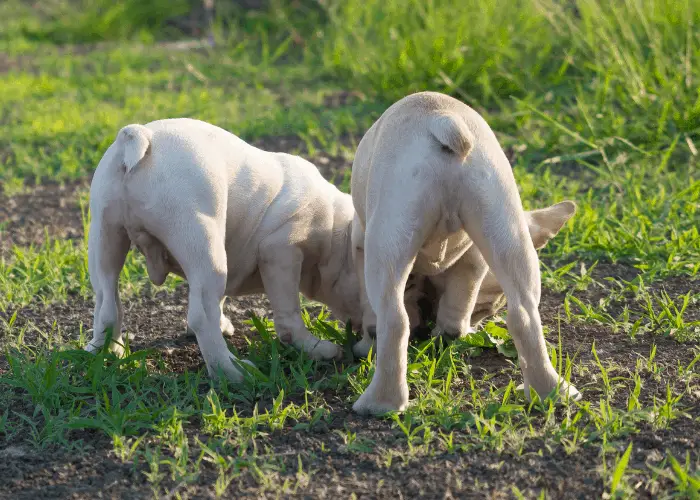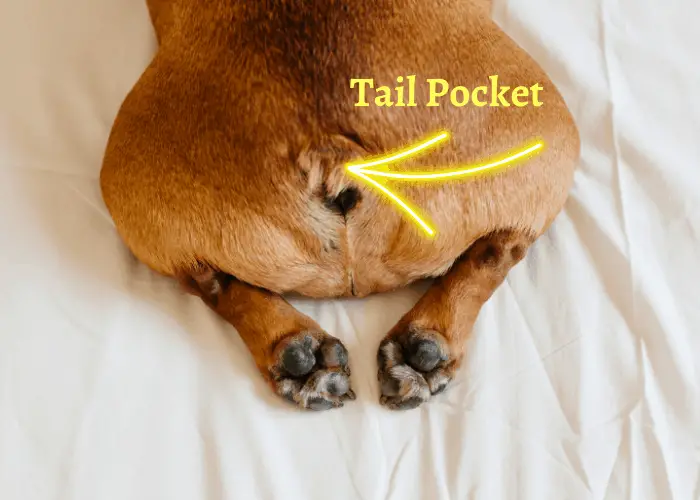Many French Bulldog owners and others who may be interested in owning one of these dogs someday may wonder if the tail of the French Bulldog is cut to be short and stumpy or if they’re just born that way. Could their tails get docked at birth for aesthetic reasons?
French Bulldogs are born with naturally short and stumpy tails, not docked or just cut short. This “natural bobtail” is due to a dominant or recessive mutated gene that grows unusually short or is missing completely.
But why does a French Bulldog’s tail look the way it does? And is there variety in how their tails are shaped or are they all typically the same? We’re going to explore these questions and more in the rest of the article, so read on to learn all there is to know about French Bulldogs and the reason why their tails are so incredibly stubby.
Do French Bulldogs Really Have Tails?

Some French Bulldogs may appear to not even have a tail. Well, French Bulldogs do indeed have tails, they’re just much shorter than the standard length tails ( a.k.a natural bobtail ) of your average dog breed.
The reason they have such short tails is because of selective breeding that resulted in this special length of tail. Someone once thought these stubby tails would be cute, and so it was bred into them!
Different Types of French Bulldog Tails
Yes, even though French Bulldogs all have short little tails, they still come in a variety of lengths, sizes, and shapes. Typical varieties of tails include:
- stumpy tails
- a tail that hangs straight down
- a corkscrew tail
- fine-tipped tails
- straight tails.
Breeders must adhere to strict breeding standards in regards to the tail of the French Bulldog, making sure the tail is not curly, while at the same time ensuring that it is still short and hung low with a thick root and fine tip. Their tails must also not stick up in the air but hang low over the rear instead.
Do French Bulldogs Run into Problems Because of Their Tails?

Because of the extensive breeding of French Bulldogs over the generations, they are known to sometimes have problems with their tails. They can become malformed, growing in an unhealthy manner, and sometimes can cause pain and discomfort for the dog.
All French Bulldogs are prone to tail problems, but incorrect or irresponsible breeding practices can exacerbate the situation. But let’s take a closer look at the specific issues that can crop up.
Pocket Infection in French Bulldog Tails

One major issue French Bulldogs face with their stumpy tails is known as pocket infection. Many French Bulldogs have deep tail pockets which can often become infected if not cleaned and taken care of properly. If your Frenchie has one of these types of tail pockets, you’ll want to make sure to thoroughly and frequently clean it to prevent infection from setting in.
Some tell-tale signs of a pocket infection in your dog’s tail are red, irritated skin on and around the tail, and signs that the area is itchy. You’ll be able to tell if your dog is acting particularly fussy with its tail or rear region, trying to scrape it across various surfaces to get rid of the itch. You may also notice a strong odor accompanied by discharge, which is indicative of a bacterial infection.
If a pocket infection is left untreated for too long, it may require special pocket surgery from a qualified veterinarian. Therefore, it’s extremely important to stay on top of the hygiene of your French Bulldog’s tail pocket.
Hemivertebrae in French Bulldogs

Another pocket problem that may plague your Frenchie is a hemivertebra( image source). You may have heard of the term “hemivertebrae” before, and essentially it is defined as a vertebra or multiple vertebrae that have become deformed. This problem is often present from the moment the dog is born and can be hard to notice in some cases.
Specifically, a hemivertebra forms when two vertebrae fuse together and develop incorrectly during growth. This can often cause the dog’s spine to become twisted or curved, instead of straight as it should be. This is a particularly serious issue because the twisting of the Frenchie’s spine can lead to nerve damage and severe pain.
If you see a French Bulldog with a screw tail, you can bet that they are affected to some degree by hemivertebrae. The severity of this defect can range from mild to severe, but many times it will require special treatment to solve. Severe cases can seriously impede the day-to-day functions of a Frenchie’s life.
How to Treat Hemivertebrae

If for some reason you think your dog suffers from hemivertebrae, you’ll want to seek a second opinion immediately from a qualified veterinarian. They will be able to diagnose your dog’s condition quickly and painlessly by doing a physical and x-ray. In certain cases, they may need to run a CT scan to be sure.
Most treatments for hemivertebrae will come as a prescription for anti-inflammatory drugs that will help treat swelling and pain in your dog’s spine. However, certain extreme cases may require surgical treatment to reverse nerve damage and set the spine straight.
In these cases, don’t worry. Vets are trained to handle these types of situations and should be able to resolve the issue quickly and painlessly, though the recovery may be long and uncomfortable afterwards. The important thing is that your dog will eventually be all back to normal!
Do All French Bulldogs Have a Tail Pocket?

A tail pocket is a tiny indentation on the dog’s rear under its tail that looks a bit like a dimple. It can gather dirt and debris over time and can be prone to infection and other problems. Not all French Bulldogs have tail pockets, but there are many that do, and there can be a plethora of issues they may run into because of this.
How to Clean a French Bulldog’s Tail Pocket

If you’re a new owner of a Frenchie, it can be a bit daunting knowing exactly how to care for your pet. Even if you’ve owned one for a while, there may be some good tips for you to know to assist in cleaning difficult areas on your dog.
Now don’t be afraid to don your rubber gloves for this process, as it can get pretty dirty in there.
- To start, use warm water and gentle soap to wipe the outer area clean of any built-up dirt or moisture. These can be irritants for your Frenchie’s tail pocket and can lead to infection.
- Next, you’ll want to gently lift the tail and wipe its underside, as well as the skin underneath where the tail normally rests. This will keep the area clear of any potential contaminants.
- Instead of normal soap, some Frenchie owners have instead gone with a 50/50 solution of water mixed with apple cider vinegar. Because of apple cider vinegar’s anti-fungal and anti-inflammatory properties, this can add additional defense to the area, making doubly sure no infection starts. This treatment has also been proven to help heal yeast infections in your dog too, which can be handy.
- If you want to be extra sure no irritation or infection sets into your Frenchie’s tail pocket, you can also use a diaper rash cream that has Zinc in it. Zinc has skin strengthening properties that will fortify your dog’s skin and make it more resistant to infection and irritation. Additionally, it may relieve tenderness or soreness from irritated skin and can help to reduce the production of skin oils in the area.
Final Thoughts

French Bulldogs, as cute as they are, can come with a lot of extra maintenance and care required to keep them in tip-top shape. Proper hygiene and cleanliness of certain areas on their bodies, like tail pockets, if they have them, are essential in preventing health problems like pocket infection and skin irritation.
Additionally, many of them may be born with spine defects that can cause pain or loss of motor control later in life, and this should be treated as soon as possible. Many times, a problem like this will manifest as early as nine months, and if you do notice anything unusual with your Frenchie’s movements or spinal region, you should take them to a Vet right away.
But despite all the health issues that can come with French Bulldogs, they’re still super cute and companionable little dogs. If you’re willing to put in the work required to keep them healthy, then your Frenchie will surely become one of the best canine companions you could ask for!
We hope the information we outlined above will help you know how to take care of them in the right way so that major health issues can be treated or prevented early on.

